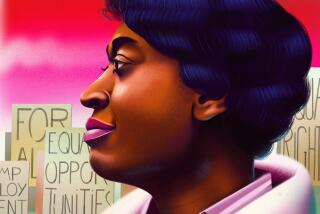Op-Ed: Real change on race issues has never come without struggle
Many Americans are invoking the Civil Rights Movement as a model for today’s efforts to create systemic change. We cherish stories of that time as we do comfort food. But there is a lot of warped nostalgia about the movement. We want to roll tape of protesters walking arm and arm singing, “We Shall Overcome” and forget how often the Black people leading the movement were overcome — attacked by dogs, trampled, hosed down and even murdered.
Our diluted version of how change happens is ahistorical at best, and more alarmingly, gives a false model for how to accomplish reform. The political gains of the Civil Rights Movement were significant, but they did not happen without violence and struggle, and even then they didn’t begin to address economic inequity, which is at the core of inequality and racism. If Americans want to see substantive change, history suggests we go back further to find a blueprint.
No other time in American history shows what it takes to achieve major change than the fight to abolish the institution of slavery. At the start of the Civil War, more than 4 million Black people were in bondage. One in three Black people faced separation from their families at the auction block. Black people’s life expectancies were inextricably tied — inversely — to the market. When cotton prices were high, life expectancy for Black Americans shortened. Enslaved people were property. Abolitionist Theodore Parker, put it plainly: Black people were “things”; they could be “damaged but not wronged.” The only way America overthrew this violent and oppressive system was through the Civil War.
The abolitionist movement was founded on peaceful principles. Many white abolitionists believed that they could morally persuade slaveholders that slavery was wrong. White abolitionist William Lloyd Garrison, one of the founders of the American Anti-Slavery Society, believed in a “turn the other cheek” ideology. But throughout the antebellum period, free Black Americans saw their churches, businesses and schools destroyed by white mobs seeking to preserve the status quo: Black subordination. During the time of the abolitionist movement, not only were runaway slaves tracked down in the North and returned to bondage with the Fugitive Slave Law, but the Supreme Court declared that even free Black people “had no rights which the white man was bound to respect.”
Some in the movement realized it would take more than persuasion to abolish slavery. As Quaker and white abolitionist Abby Kelley Foster put it: “Since slavery was maintained by force, it might justly be opposed in the same way.” She added, “The question is not whether we shall counsel the slaves to forsake peace, and commence war; the war exists already, and has been waged unremittingly ever since the slave has been in bondage.” And to be clear, Black America did not start the conflict.
It cost something to abolish slavery; it was one of the most prosperous institutions in the world. The overthrow of slavery required slave owners to forfeit their property and wealth. It cost lives, land and liberty. After the Civil War, the United States had to reconstruct itself.
But even as the country abandoned slavery, it didn’t address the underlying racist assumptions of that institution, which couldn’t have existed without a belief that Black people were inferior. Frederick Douglass was prophetic in saying that, “until it is safe to leave the lamb in the hold of the lion, the laborer in the power of the capitalist, the poor in the hands of the rich, it will not be safe to leave a newly emancipated people completely in the power of their former masters, especially when such masters have ceased to be such not from enlightened moral convictions but irresistible force.”
Today, if America were a house, fixing racism would not involve repairing broken windows or fixing leaking roofs. America’s systemic racism is asbestos and black mold. It requires a gut job. Americans should not expect real reform with the simple throwing out of a few bad apples in a few police departments. Change is not prison sentences for several crooked cops. Change is a completely new system.
Black people today do not want renovations of the existing power structures. They want a new normal where the loss of Black life is not status quo. And true change will involve the forfeiture of power by some of those who now hold it, which has never come easily.
Progress will be possible only if it begins from a shared idea that the ongoing degradation of Black people is unacceptable. With hard work, legislative backing and relentless monitoring, it may be possible to make the necessary changes peacefully. But as the occasional flareups of violence at recent protests have shown, there is a limit to patience.
Force and violence were embraced by abolitionists only after decades of nonviolent organizing, demonstrations, and moral suasion failed to protect Black people and failed to produce liberation. Political violence was a rational and calculated pivot after decades of failed policies and impotent investigations. Systemic change today will require more than taking a knee or creating a hashtag. To avoid violence, changes will need to go beyond taking down statues, lowering Confederate flags and removing racist films. It will mean creating a new replaced system based on equality, equity and meaningful remedy.
Those who fought to end slavery sought not to reform it, but to abolish it. Like the abolitionists, anti-racist activists today are demanding that Americans divest themselves of something they do not need: white supremacy.
Kellie Carter Jackson is a professor of humanities in the Department of Africana Studies at Wellesley College. She is the author of “Force and Freedom: Black Abolitionists and the Politics of Violence.”
More to Read
A cure for the common opinion
Get thought-provoking perspectives with our weekly newsletter.
You may occasionally receive promotional content from the Los Angeles Times.










